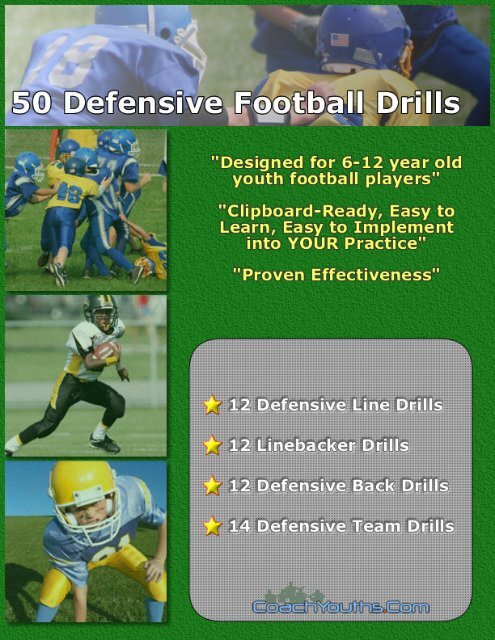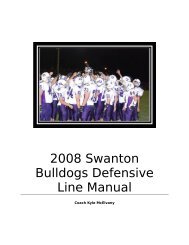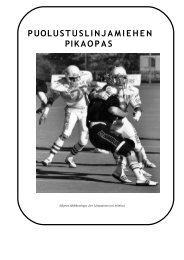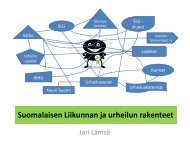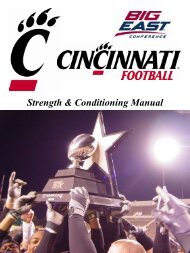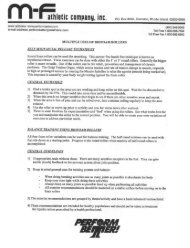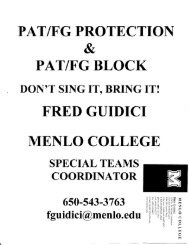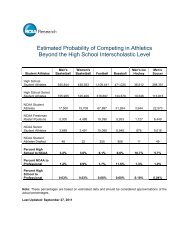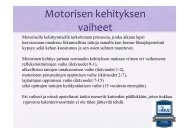50 Defensive Football Drills
50 Defensive Football Drills
50 Defensive Football Drills
- No tags were found...
Create successful ePaper yourself
Turn your PDF publications into a flip-book with our unique Google optimized e-Paper software.
Presents<strong>50</strong> <strong>Defensive</strong> Youth <strong>Football</strong> <strong>Drills</strong>WamerSports NetworkVista CA, 92083
<strong>50</strong> <strong>Defensive</strong> Youth <strong>Football</strong> <strong>Drills</strong>Table of ContentsIntroduction ………………………………………… 4<strong>Defensive</strong> Line <strong>Drills</strong> ………………………………………… 5Linebacker <strong>Drills</strong> ………………………………………… 18Secondary <strong>Drills</strong> ………………………………………… 31<strong>Defensive</strong> Team <strong>Drills</strong> ………………………………………… 44………………………………………………………………………………………………………………………………Distribution DisclaimerCoachYouths.Com releases you as the purchaser to use, make copies and distributethis FILE and the drills included in this file with the following limitations:1. You may distribute freely to fellow coaches, however CoachYouths.Comreserves ALL other rights to this material.2. You may NOT re-sell this playbook or any material related to this playbook.3. You may NOT list this playbook as being “Included” in any product that isbeing sold.4. You may NOT place this material on your website, BLOG, newsletter, etc,without getting prior approval from our coaching staff.5. You may NOT modify this material in any manner before distributing amongyour fellow coaches.
IntroductionFirst we would like to thank you for purchasing our “<strong>50</strong> <strong>Defensive</strong> <strong>Football</strong> <strong>Drills</strong>”.We know that you have found the right drills for your youth football team, and wehope you enjoy using them and find a high level of success and satisfaction.Our coaching staff has been using these drills and variations of these drills for over20 years and still finds them to be very effective today.The key to a good football drill is that it must keep the players attention whileteaching them a needed skill, these drills will do that. They are challenging, yetsimple enough for an experienced youth football coach to implement into his practiceplan.So we hope you enjoy using these drills and please do not hesitate to contact us withany questions, comments or concerns regarding these drills.Thank You,John WamerFounder, CoachYouths.ComWe also have “<strong>50</strong> Offensive <strong>Football</strong> <strong>Drills</strong>” available as well:http://www.youth-football-drills.com
<strong>Defensive</strong> Line <strong>Drills</strong>
3-on-2 DrillPurpose:Number of Players:Equipment:Time:To teach defensive linemen to react to and recognize different schemesAll <strong>Defensive</strong> LinemenShorts or Full Pads2 minutes/everydayDrill Execution:Coaching Points:1) Three offensive linemen line up on line ofscrimmage with two defensive linemen across theLOS.2) The coach stands behind the defensive linemen tosignal the scheme and the snap count, the coachalso calls the cadence.3) The coach teaches the defensive line to watch theball and to get off the line at the snap.4) The defensive line reacts to the blocking scheme onthe run.1) At the snap the DL take a proper gap control step,then read and react to blocking scheme, do not tryto guess the scheme.2) The diagram is for an inside TRAP play, the coachshould have the scout offensive line run severaldifferent blocking schemes.NOTE:This is an excellent drill for improving recognition of blockingschemes and reacting to schemes.
Hustle DrillPurpose:Number of Players:Equipment:Time:To improve pass rushing technique and pass pursuit techniqueAll <strong>Defensive</strong> LinemenShorts or Full Pads2 minutes/everydayDrill Execution:Coaching Points:1) Five defensive linemen line up across from fiveoffensive linemen as diagramed above.2) Five wide receivers line up downfield asdiagrammed between 12-15 yards deep.3) Mark the pass lines with spray paint or tape ifavailable so the defensive line can practice theproper rush lane.4) On the QB snap one defensive linemen will go at atime, and will have 4 seconds to beat the block andget to the QB which will make a 7-step drop.5) If the DL does not touch the QB in four seconds theQB will throw the ball downfield and the DL willhave to sprint to the WR with the ball.1) The DL has to react to the snap of the ball not thecadence, should be watching ball not anticipatingthe snap count.2) During the pass rush the DL works on techniqueand staying in the proper rush lane.3) This can become an excellent conditioning drill foryour DL.4) Once the DL has gone his turn he will rotate to theOL side.NOTE:DL should focus on technique and execute drill faster as histechnique improves. OL should make all out effort to makea block.
3-on-1 Drill with ConesPurpose:Number of Players:Equipment:Time:To teach the defender to deliver a blow, separate and pursue the ball carrier.<strong>Defensive</strong> LineFull Pads2 minutes/everydayDrill Execution:Coaching Points:1) The setup has a Center, two guards and a ballcarrier, these players can be actual offensiveplayers, or can be played by the defensive linemenwho are not currently running the drill.2) You will need to place the cones as illustratedabove to simulate the offensive tackles and tightends, and to create a lane for the ball carrier to runthrough.3) The coach will give the snap count to the offense,then will position himself behind the defensiveplayer (the triangle), the coach will then signal tothe offense the direction (left or right) they playwill be run to, without the defender knowing.4) The coach will call out the snap count and theoffense will execute the play as drawn to eitherside. The diagram is to the right side, so based onthe diagram, the guard will attempt an inside blockon defender, the defender will explode into theblock with his hands to create separation, then willpursue the running back to the hole, where he willhave to separate again from another blocker, thenmake a tackle on the back.1) The coach should be checking for proper startingstance.2) The defender should maintain a low center ofgravity so that he can explode into blockers andcreate separation.3) Insure that the defender is exploding with bothhands into the chest of the defender to keep himseparated from blocker.4)NOTE:This drill can be run at full speed, or full speed until thetackle is going to be made and have the players not make afull tackle, unless you want to work on tackling while doingthis drill.
Eagle Rush DrillPurpose:Number of Players:Equipment:Time:To improve pass rush technique and teach pass rush lanesAll <strong>Defensive</strong> LinemenShorts or Full Pads2 minutes/everydayDrill Execution:Coaching Points:1) Five <strong>Defensive</strong> Linemen line up across from 5offensive linemen as diagrammed above. The DLalign in their respective rush lanes, i.e. inside,outside or head up.2) All five DL align properly and assume a goodstarting stance, ready to rush. Place a dummy orcoach 6 yards behind the OL, this is the “targetarea.”3) The offensive line will attempt to pass block, usingproper blocking technique and at full effort.4) The offensive line coach will give the OL the snapcount as well as call out the count.5) The defensive coach will choose the defender whorushes on the snap, only one will rush at a time.6) On the snap the defender will rush the assignedrush lane, all OL will start to block, then theoffensive linemen assigned to the defender whorushes will be the only one blocking.7) The object is for the defender to get to the targetarea, if stopped short the defender should get hishands up to attempt to block a pass.1) The defender starts on the first movement by theoffensive line.2) The defender MUST stay in the assigned rushlanes.3) The offensive or defensive player who succeedsscores a point for their team.4) If there is a player setup in the target area as theQB, the defender should tackle chest high and thenrelease, not drive the QB to the ground since theQB will not be able to move out of the pocket forthis drill, this will prevent injuries
Leverage DrillPurpose:Number of Players:Equipment:Time:To <strong>Defensive</strong> End the proper reaction to offensive blocksAll <strong>Defensive</strong> LinemenShorts or Full Pads2 minutes/everydayDrill Execution:Coaching Points:1) Coaching Leverage:a. The DL is shaded (offset, not head-up) offthe offensive linemen.b. The OL starts the drill by attacking the DLnear pad.c. The DL attacks and squeezes the OL, hekeeps his head and eyes in his “gap” untilthe coach signals to release and“crossface” or to push into his gap.2) Coaching Reach Technique:a. The DL is shaded (offset, not head-up) offthe offensive linemen.b. The OL starts the drill by attacking acrossthe far pad of the DL.c. The DL uses his hands to keep the OL offhis legs and works to gain an outsideposition.3) Coaching Low Block Technique:a. The DL is shaded off the OL, the OL startsthe drill by low blocking on all fours to thefar knee of the DL.b. The DL responds by getting helmet onhelmet contact and hands on shoulderpads, to force the OL away from his knees,then pushes up field.1) Teach the proper use of hands and feet during alldrill variations.2) Teach the proper release off the offensive blockduring each repetition, help it become instinctiveand “muscle-memory”.NOTE:All <strong>Defensive</strong> linemen will sprint 5-10 yards up field uponcompletion of each drill.
Hoop DrillPurpose:Number of Players:Equipment:Time:To teach <strong>Defensive</strong> Linemen to get off the ball quickly and under controlAll <strong>Defensive</strong> LinemenShorts or Full Pads2 minutes/everydayDrill Execution:Coaching Points:1) Place two hoops on the ground 1 yard apart, eachhoop should be 7-feet in diameter, use rubber hoseor garden hose for this.2) Right side defensive linemen line up on the rightside and left side defensive linemen line up on theleft.3) A coach lines up on each side, at the starting point,and where the player running the drill can see hisfeet.4) The players start in a three point stance and on themovement of the coaches feet the player will runthe hoops. Alternate one player from each side ata time.1) The coach should time the players while runningthe drill and call out the times so players can tracktheir times and this creates competition amongyour players.2) You must insist that the players start in a properthree point stance.3) Insure the players are using proper body controlwhile running the drill.4) You want speed, however don’t allow the players tosacrifice control over speed.
4-Point Stance DrillPurpose:Number of Players:Equipment:Time:To teach proper 4-point stance<strong>Defensive</strong> Line <strong>Drills</strong>Shorts or Full Pads2 minutes/everydayDrill Execution:Coaching Points:1) All defensive linemen line up on a line facing thecoach.2) On the “SET” command players will bend theirknees and rest forearms on the inside of theirthighs.3) On the “STANCE” command each player assumesthe 4-point stance.4) Coach will scan up and down the line makingcertain that everyone is properly set.5) On the “UP” command the defensive linemen willget out of the stance and back to an uprightposition.1) Have players line up with feet even, shoulder-widthapart, in an upright stance.2) On the set command check for proper knee bends,forearm placement and a straight back.3) When player is in the 4-point stance his weightshould be resting on the ball of his feet. Hipsshould be up, at least shoulder pad level or higher.
<strong>Defensive</strong> Line Start DrillPurpose:Number of Players:Equipment:Time:To teach defensive linemen the proper stance and to explode on snap.All <strong>Defensive</strong> LinemenShorts or Full Pads2 minutes/everydayDrill Execution:Coaching Points:1) All defensive linemen will line up facing the coach.2) On the “SET” command each player will bend at theknees and rest his forearms on the inside of eachthigh.3) On the “STANCE” command each player assumes a4-point stance and looks at the ball.4) Once the defensive linemen are in the properstance, the coach will grasp the ball and simulate asnap.5) The defensive linemen will explode out of theirstance and sprint 4-5 yards.6) Players will rotate thru the drill as needed.1) Have players line up with feet even, shoulder-widthapart, in an upright stance.NOTE:
Drive Block Protection Drill: DLPurpose:Number of Players:Equipment:Time:To teach <strong>Defensive</strong> Linemen proper technique to defeat a drive block.All <strong>Defensive</strong> LinemenShorts or Full Pads2 minutes/everydayDrill Execution:Coaching Points:1) Spit your defensive linemen into 2 groups. Onegroup will play the role of offensive linemen whilethe other group runs the drill a their respectivedefensive line position.2) Have the two groups line up facing each other asillustrated above.3) The coach will tell the defensive players their gapresponsibility, either left or right.4) On the “Stance command the players will get intotheir starting stance.5) The defensive linemen will focus on the ball.6) On the “HUT” command the “Center” will snap theball to the coach and the offensive blockers willmove forward to drive block the defenders.7) The defensive player reacts to the drill and drivethru the block until the whistle is blow.8) Repeat drill and switch sides.1) On the snap the defensive linemen will chargeforward while using short-powerful steps.2) The defender should keep his shoulder pad levelunder the level of his opposing blocker to maintaina lower center of gravity and to establish leverage.3) Bring both arms forward to strike the blocker in thechest with the palm of his hands.4) As he makes contact he should slide his head to hisresponsible gap.5) Then attempt to drive the blocker backwards.NOTE:
Hook Block Protection Drill: DLPurpose:Number of Players:Equipment:Time:To teach defensive linemen how to react and defeat a hook blockAll <strong>Defensive</strong> LinemenShorts or Full Pads2 minutes/everydayDrill Execution:Coaching Points:1) Split your defensive linemen into 2 groups. Onegroup will play the role of offensive linemen whilethe other group runs the drill a their respectivedefensive line position.2) Have the two groups line up facing each other asillustrated above.3) The coach will tell the defensive players their gapresponsibility, either left or right.4) On the “Stance command the players will get intotheir starting stance.5) The defensive linemen will focus on the ball.6) On the “HUT” command the Center will snap theball to the coach and the blockers will step to theside assigned by the coach to make a hook blockon the defensive player across from them.7) The defensive player will shed the block attemptand push into the backfield in his respective rushlane until the whistle is blown.8) Repeat the drill and then rotate sides.1) While the defender starts his rush on the snap heshould see the head and upper body of theoffensive linemen attempting to move to hisoutside for the block.2) When he sees this action the defensive linemenshould strike the shoulder pads and upper body ofthe blocker with his hands straight ahead.3) The defensive linemen should continue extendinghis arms after the initial contact; this will helpcreate separation from himself and the blocker.4) At this point he will be separated from the blockerand will drive him down the line, this will help forcethe play inside the block, inside of allowing a playto bounce outside.5) It is VERY important to for the defensive linemen tokeep his head outside of the blocker and shoulderssquared to the opposing backfield to maintainproper balance.6) Also insure your players maintain a wide base attheir feet, not too narrow and not extremely wide,shoulder-width or just outside the shoulders isperfect.
Target Rush Drill: DLPurpose:Number of Players:Equipment:Time:To teach <strong>Defensive</strong> Linemen how to properly rush a target areaAll <strong>Defensive</strong> LinemenShorts or Full Pads2 minutes/everydayDrill Execution:Coaching Points:1) First align your defensive line on the line ofscrimmage. The coach will assume the centerposition and simulate snapping the ball. Place acone or other marker to designate where the QBwill be.2) On the “STANCE” command the defensive linemenwho is running the drill will assume the properstarting stance.3) When the player is set in his stance the coach willgrasp the ball and simulate a snap count and thena snap. The defensive linemen will react to thesnap.4) The defensive lineman will rush the QB until thewhistle is blown, then rotate to the next player orrepeat.1) Insure that your defensive linemen are makingtheir first step forward, do not allow them to stepbackwards at all, explain to them that by steppingback even a half step is automatically giving upground to the offense.2) The defensive lineman’s initial charge should be lowbut the body should rise as he gets closer to theQB.3) Empathize that every player plays until the whistle,meaning they should run thru and past the QB areauntil the whistle is blown, not just to it and thenstop.
Bull Pass Rush DrillPurpose:Number of Players:Equipment:Time:To teach the defensive linemen to properly rush the QB.All <strong>Defensive</strong> Linemen and Offensive LinemenFull Pads4 minutes/twice weeklyDrill Execution:Coaching Points:1) Align your offensive line and your defensive line onthe ball, place the QB or a marker simulating theQB 4-5 yards behind the line of scrimmage.2) Coach will designate which defensive linemen andblocker will execute the drill.3) The defensive linemen should picture himselfrushing thru the offensive linemen, this is a forcedrush and power and explosiveness will prevail.4) The center will simulate a snap on the “HUT”command from the coach; the two players willexecute the drill.5) The drill ends when the coach blows the whistle.1) Should have rusher execute drill at half speed whenfirst teaching this drill.2) As with any rush make sure the defensivelinemen’s first step is forward, not to the side andnot backwards.3) The rusher should be low to the ground coming upand will rise as he gets closer to the QB.4) When the rusher gets close to the blocker, heshould explode into him with the palm of his handsunder the blockers shoulder pads, as his handsmake contact in the armpit area he should extendhis arms fully to create separation.5) Emphasize the goal is to push the blocker straightback into the QB.
Linebacker <strong>Drills</strong>
Ricochet Drill`Purpose:Number of Players:Equipment:Time:To teach linebackers techniques to defeat blocking schemesAll LinebackersFull Pads2 minutes/everydayDrill Execution:Coaching Points:1) Three blockers align 5 yards apart on a line.2) The ball carrier (with optional shield) aligns 5 yardsbehind the last blocker.3) The LB, in the correct starting stance and positionaligns 5 yards in front of the middle blocker.4) The coach aligns 2 yards behind the middleblocker. The coach will simulate a snap count andwill blow the whistle to start the drill.5) The LB will attack to the left first, then the middle,the last blocker before ripping thru to make a formtackle on the ball carrier.1) The THREE different blocks the LB will face.a. A down block to the outside shoulder.b. A cut block to the knees or shins.c. A base block to the middle upper body.2) Teach the LB what every type of block attempts toaccomplish and how to defeat each type.3) The LB should use the RIP technique to gain accessto the RB thru the last blocker.4) Thru the entire drill the LB must maintain footmovement while keeping his shoulders squared toprovide pad leverage.5) The drill is over when the form tackle is completedor on a second whistle blow from the coach.
Box Reaction DrillPurpose:Number of Players:Equipment:Time:To teach linebackers to change direction while keeping eye on the ballAll LinebackersShorts or Full Pads2 minutes/everydayDrill Execution:Coaching Points:1) The drill station is a 10-yard square, with a cone orother marker at each corner.2) Two LBs line up 1 yard apart on the baseline facingthe coach.3) To start the drill the coach blows a whistle, the LBsfocus on the ball in the coach’s hands and goes inthe direction he points it.a. As the coach points straight back the LBswill backpedal.b. As the coach points at a cone in eithercorner, the LBs respond by opening theirhips and performing crossover runs.c. As the coach points to different areas theLBs reset and respond in that direction.d. To end the drill the coach points at a spotdirectly in front of him, the LBs plant theirfeet and sprint to him, the coach will tossthe ball in front of the and the LBs shouldattempt to intercept it at the highestpoint, then sprint thru the coach.1) The LBs need to learn how to move and reactquickly in different directions without losing controlof their bodies.2) The LBs must keep their feet up and under, or theywill lose their base and slip and fall.3) Thru the entire drill the LBs should maintain eyecontact with the coach and the ball in his hands.4) The LBs should move to the specific point withoutlooking at it.
Linebacker Skate DrillPurpose:Number of Players:Equipment:Time:To teach linebackers to defeat high or low blocksAll LinebackersShorts or Full Pads2 minutes/everydayDrill Execution:Coaching Points:1) To drill OUTSIDE LBs:a. The offensive players align as diagrammedon the right side above.b. For drill purposes the ball carrier will bethe TB.c. The outside LB will align to the outsideshade of the TE.d. The coach will callout a snap count, on thecenter’s snap the TE will attempt anoutside hook block, the RB (with ball) willsweep outside, and the FB will lead blockoutside and attempt a cut block on theoutside leg.e. The LB will defeat the hook block byexploding his hands into the outsideshoulder of the TE and extending his armsfor separation.f. The LB will defeat the CUT block bylowering his body and exploding his handsinto the FB’s helmet as he goes down,forcing the FB into the ground before hegets to the legs of the LB, and the LB willmake a small outside shuffle step to createenough separation to avoid the block.g. Makes a good form tackle.2) To drill INSIDE LBs:a. The inside LB aligns to the outside shadeof the G at a 4 yard depth.b. At the snap the G attempts to block theLB, who defeats it with a rip technique.c. The Lb then defeats the cut block asdescribed aboved. The LB executes a good form tackle on ballcarrier1) Insure the LB maintains a good hitting position thruthe entire drill.2) Teach the LBs to defeat low blocks with theirhands, not jumping over the blockers. Explain tothem that although they may get away withjumping the block attempt that they cannot changemovement directions in mid-air and this couldallow the RB to make a quick cut and avoid thetackle, effectively taking themselves out of theplay.3) Start executing this drill at half speed then increasethe speed.
Downhill Shuffle DrillPurpose:Number of Players:Equipment:Time:To teach LBs to attack the line and use hands to avoid blocksAll LinebackersShorts or Full Pads2 minutes/everydayDrill Execution:Coaching Points:1) Place FOUR bags at an angle within a ten yardarea. (If no bags are available a line of cones orstrips of rope or even rubber hose will work, justinsure the LBs are forces to raise their feet to clear8-12 inches.2) Four blockers align between the bags (diagrammedabove).3) The ball carrier aligns 10 yards outside the lastbag.4) Facing the blockers the LB aligns left of the firstbag.5) On the whistle the LB steps with his near foot toshuffle over the bag.6) Within the bag area the blocker steps forward andexposes his chest when the LBs trail foot hits insidethe bag area.7) The LB will string the chest area of each block withthe palm of his hands and extend his arms tocreate separation before shuffling to the nextblocker.8) Blocker #4 will attempt a low block after the LB hascrossed the last bag.9) After shedding the low block the LB will sprint tothe ball carrier and perform an angle tackle.1) Insure the LB assumes a good starting position andthat he maintains a good position throughout thedrill.2) The LB wants to keep is center low, by alwayskeeping his tail just below waist level so he canspring into is opponent, insure the LB is notstanding straight up as he shuffles.3) The ball carrier does not move until the LB hasshed the low block and the drill is not over till thewhistle is blown.
Linebacker Shoulder Blast DrillPurpose:Number of Players:Equipment:Time:To teach LBs skills to defeat blocks while pursuing the ball.All LinebackersShorts or Full Pads2 minutes/everydayDrill Execution:Coaching Points:1) On a line three blockers align one yard apart.2) Facing the blockers in a good starting stance, theLB aligns two yards in front of them.3) The coach stands behind the LB and signals eachblocker when to attack.4) On blocker movement the LB attacks and explodesinto the blocker using his outside shoulder andhands to create separation.5) After exploding into and defeating the first twoblockers the LB resets to the starting position.6) On the third blocker, the LB explodes into theblocker’s chest with both palms, locks out his armsand drives the blocker backwards.1) When attacking the blocker the LB’s aiming point isthe chest.2) The LB should start his attack with a power step(inside foot) that splits the crotch of the block,causing him off balance.3) When the executing the lockout technique the LBbends his knees and arches his back.NOTE:All ball carrier can be added, if so the LB sheds the blockerand makes a form tackle from the lockout position on thelast blocker.
Open Field Tackling DrillPurpose:Number of Players:Equipment:Time:To teach LBs proper angles and body position during open field tacklingAll LinebackersShorts or Full Pads2 minutes/everydayDrill Execution:Coaching Points:1) Organize 5 cones 2 yards apart as illustratedabove.2) Place two dummies or two rows of 3-4 cones eachat an angle to create a running lane that the ballcarrier must stay within.3) The defender (triangle) starts at one end 10-yardsaway from the cone group, while the ball carrierstarts at the other only 5 yards away from thecones.4) The drill starts on the coach’s command, either ona whistle blow or verbal command.5) The ball carrier starts thru the cones and breaks ineither direction, while the defender attacks thecones in the same direction as the ball carrier.6) While moving at full speed the defender mustattack under control and execute a proper angletackle.1) The defender should always start the drill twice asfar from the cones as the ball carrier since he willbe required to cover more ground on game day.2) As your defenders improve you may allow the ballcarrier to perform a fake in one direction or even acut back to truly test your linebackers.3) Teach the ball carrier to run up field when comingout of the cones, not away from the defender.4) The linebackers should work his way inside out onthe ball carrier by attacking his hips; he will tackleacross the front of the ball carrier with his body.5) Teach your defenders to force the ball carrier to thesideline or back inside to the heart of the defense,but not to allow them to get the outside on them.
2-Point Stance DrillPurpose:Number of Players:Equipment:Time:To teach linebackers the proper 2-point stance.All LinebackersShorts or Full Pads2 minutes/everydayDrill Execution:Coaching Points:1) Have all of your linebackers lineup in a line facingyou.2) On your command of “STANCE”, each player willbend at the knees and get into a proper 2-pointstance.3) The coach will scan the line to insure all players arein correct stance and fix the ones who are not.4) On the command of “UP the players rise back tothe upright relaxed position.5) Repeat as required.1) Early on you should go down the line one player ata time to insure that EVERY player gets one on onecorrections and demonstration of the stance.2) Players should:a. Be lined up with their even;b. Feet shoulder width apart;c. In an upright stance.d. All players bend at the knees, positiontheir shoulders slightly in front of theknees.3) Outside linebackers should adjust so that theiroutside foot is back.
Start Drill: LBPurpose:Number of Players:Equipment:Time:To teach linebackers the proper alignment to the ballAll LinebackersShorts or Full Pads2 minutes/everydayDrill Execution:Coaching Points:1) Group your linebackers in to groups based on thenumber you will have on the field at one time, forexample if you run a 4-3 or 5-3 you will have themin groups of 3. Have then lineup on you, as if youwere the ball.2) On the “STANCE” command they will assume anappropriate 2-point stance.3) The coach should grasp the ball, simulate a snapthen move left or right and the linebackers shouldreact accordingly.4) Reset and repeat as required.1) Go one player at a time early in the season toinsure every linebacker gets one on one coaching ifneeded.
Drive Block Protection Drill: LBPurpose:Number of Players:Equipment:Time:To teach linebackers to defeat the drive blockAll Linebackers and scout team offensive lineShorts or Full Pads2 minutes/everydayDrill Execution:Coaching Points:1) Have your linebackers line up properly facing anoffensive line, coach will assume the position of QB.2) The coach will tell the LBs their gap responsibility,either left or right.3) On the “STANCE” command all players get into theproper stance.4) Linebackers should focus on the ball, NOT the snapcount.5) On the “HUT” command the center snaps the ball tothe coach and the blockers move forward to driveblock the defenders backwards.6) The linebackers react to the blockers.7) Coach either calls “STOP” or blows the whistle toend the drill.8) Players rotate, switch positions or repeat asrequired.1) On the snap the linebacker steps forward withsmall, powerful steps.2) As he comes forward he needs to keep his shoulderpad level below that of the offensive linemen.3) Once the blocker gets close, the LB should explodewith both arms forward with his palms striking theblocker in the chest, it should be a up and outmotion if the linebackers pad levels are lowenough. This will create leverage and separation.4) The LB should then shed the blocker the sideopposite his assigned gap responsibility or drivethe blocker backwards into the backfield.
Hook Block ProtectionPurpose:Number of Players:Equipment:Time:To teach linebackers to defend against a hook blockAll LinebackersShorts or Full Pads4 minutes/twice weeklyDrill Execution:Coaching Points:1) Have your linebackers line up properly facing anoffensive line, coach will assume the position of QB.2) The coach will tell the LBs their gap responsibility,either left or right.3) On the “STANCE” command all players get into theproper stance.4) Linebackers should focus on the ball, NOT the snapcount.5) On the “HUT” command the center snaps the ballto the coach and the blockers move forward tohook block the linebacker in front of him6) The linebackers react to the blockers.7) Coach either calls “STOP” or blows the whistle toend the drill.8) Players rotate, switch positions or repeat asrequired.1) As the blocker comes of the line the linebacker willsee the offensive linemen coming to either hisinside or outside, but not directly at him.2) When a linebacker sees this, he should recognize ahook block.3) The linebacker should fire both hands straightahead, making contact with his palms on theshoulder pads and upper body of the blocker.4) He should then extend his arms, creatingseparation, and drive the blocker down the line ofscrimmage, keeping his head on the side of theblocker that is his gap responsibility.NOTE:The LB will drive the blocker down the line not backwardslike against a drive block because a hook block is NORMALLYused on an outside run, sweep or bootleg type play.
Target Rush Drill: LBPurpose:Number of Players:Equipment:Time:To teach linebackers to rush to a specific area or targetAll LinebackersShorts or Full Pads2 minutes/everydayDrill Execution:Coaching Points:1) Coach should place a cone, marker or even dummydirectly behind the center 6-7 yards deep.2) The coach instructs the linebackers that thisrepresents the QB and that is the target area thatthey are rushing to.3) On the “STANCE” command the linebackersassume a proper 2-point stance.4) Once the LBs are setup properly the coach willsimulate a snap count and a snap.5) On the snap the LBs will sprint to the target, at theline of scrimmage they will slow up for a step ortwo, then back to full speed. This will teach thelinebackers to blitz under control to prevent amisdirection type play or an agile QB from makingthem miss.1) Empathize to your LBs that their first step isALWAYS forward, never back and never sideways.2) The initial charge is straight at the line ofscrimmage; the linebacker doesn’t start anglingtowards the target until past the line. This keepsthem in their gap of responsibility.3) Players should always have their heads up andeyes open.4) Players continue past the target area or until thewhistle blows.
Bull Pass Rush DrillPurpose:Number of Players:Equipment:Time:To teach linebackers the bull rush technique for pass rushingAll LinebackersShorts or Full Pads2 minutes/everydayDrill Execution:Coaching Points:1) Coach designates which LB and blocker will run thedrill, only one pair at a time will run the drill.2) Prior to starting the drill the LB should picture thespot where the QB will be setup once the play isrun.3) On the “HUT” command the blocker sets up to passblock.4) The LB watches the ball snap and begins his blitzand see the offensive linemen setting up to passblock.5) Once the LB has pushed the blocker back to thetarget area the coach blows the whistle or calls“STOP”6) Rotate, switch sides or repeat as required.1) When first teaching this pass rush technique havethe LBs go at half speed so they are using thetechnique not just trying to outrun the linemen,cause that wont always work on game day.2) As always the first step is FORWARD.3) The LBs initial charge is towards the line.4) As he nears the blocker, he shortens his stride,lowers his hips and keeps moving forward.5) Both hands come up, palms facing the blocker andLB drives hands under the shoulder pads ofblocker.6) As he makes contact he should extend his arms tocreate separation.7) LB should be prepared to continue angle to QB andbe ready to engage block again since the blocker iswilling to give up some ground to retreatbackwards and reset for a better block.8) Set the goal for the LBs to force the linemen backinto the QB if they cannot beat them outright.
<strong>Defensive</strong> Back <strong>Drills</strong>
Hands DrillPurpose:Number of Players:Equipment:Time:To teach defensive backs to read the hands of wide recieversAll <strong>Defensive</strong> BacksShorts or Full Pads2 minutes/everydayDrill Execution:Coaching Points:1) WR aligns 8-12 yards from the sideline with the DBone yard inside and 3 yards behind.2) The QB or coach aligns 10-12 yards from theplayers on the line of scrimmage.3) On command one group of players releasedownfield.4) Once 15 yards downfield the QB throws the ballover the outside shoulder of the WR.5) The WR fades to the sideline to make the catch.6) The DB closes the gap and breaks on the ball bywatching the WR’s hands, not the ball.1) The WR will tip off the location of the ball by hishand placement.2) The DB’s inside hand should be between the WRand the ball.3) If ball is caught the DB should strip the ball withthe inside hand.4) DB should insure that the opposite hand is inposition to grab on to make a tackle if ball iscaught.5) DB should not look at ball until he is in position tomake a play and has closed the gap.NOTE:This technique is mainly focused for man-to-man coverage,however will still help during zone coverage situations aswell.
Weave DrillPurpose:Number of Players:Equipment:Time:To teach techniques to keep proper width and depth cushion on a receiver.All <strong>Defensive</strong> BacksShorts or Full Pads2 minutes/everydayDrill Execution:Coaching Points:1) The WR lines up on the line of scrimmage with theDB aligned properly across the line.2) On command the receiver heads downfield at about¾ speed, the WR will take off at an angle andweave back and forth ever so often.3) The DB will keep a proper 1-2 yard cushion and willrotate at the hips when the receiver makes achange in direction.4) If the DB loses his 1-2 yard cushion he will turncompletely to the receiver and sprint to catch up.1) Teach the DB to key off the WR’s hips to tell whenthe receiver is going to change direction. Do notallow DB to focus on the feet or upper body of WRcause they can be tricky.
Triangle Block DrillPurpose:Number of Players:Equipment:Time:To teach defensive backs how to defeat downfield blocking by wide receiversAll <strong>Defensive</strong> BacksShorts or Full Pads2 minutes/everydayDrill Execution:Coaching Points:1) DBs align in a three deep look; CBs 7-9 yards offeach WR and the SAFETY about 12 yards deep.Align WRs to the right and left of the QB (orcoach). The ball carrier aligns 5-7 yards behind theQB to receive the pitch.2) To begin the drill the defensive coach (standingbehind the defense) signals the play direction tothe offense so that the defense does not know.3) As the ball is pitched the WRs come off the line toblock and the DBs perform a pass-run read.4) After identifying a run play the CB reacts to defeatthe WRs downfield block, containing the run andforcing the ball carrier inside. Or the CB will tacklethe ball carrier if he runs outside.5) If the ball carrier runs inside the safety makes thetackle while the far side CB is in a good pursuitangle to assist the safety.1) Work in groups of 3 or four depending on yourdefensive scheme you can add an additional safetyto the drill.2) Have the QB mix in a few pass from time to time toinsure the defense is being honest and doing theirrun-pass reads.
Play the Pass DrillPurpose:Number of Players:Equipment:Time:To teach defensive backs pass coverage techniquesAll <strong>Defensive</strong> BacksShorts or Full Pads2 minutes/everydayDrill Execution:Coaching Points:1) Prior to the drill the DB should practice thebackpedal and be able to change directions (seeweave drill) and understand and recognize passpatterns.2) To start the drill, the DB lines up on a WR in mancoverage.3) The WR runs an OUT, IN or GO patent and the DBplays the ball.NOTE:1) In man coverage the DB always keeps eye contacton the receiver while looking for the ball. The DBmust never look away from the receiver.2) If unable to make an interception or deflect thepass, the DB will tear away the up field arm of thereceiver. This is the arm farthest from the flight ofthe ball.3) The DB knows that an incomplete pass gains noyards, which is a plus.4) The coach emphasizes that each player should bethe best at his position, maintain peak condition,and know his responsibility.
Zone Break DrillPurpose:Number of Players:Equipment:Time:To teach defensive backs fundamentals for reading the QBAll <strong>Defensive</strong> BacksShorts or Full Pads2 minutes/everydayDrill Execution:Coaching Points:1) As a stationary WR aligns on each hash mark, theDB splits the difference and aligns between them.2) The QB (coach) aligns 15 yards directly in front ofthe DB.3) On the ball movement the QB takes a 3-5 stepdrop, at the same time the DB pedals backwards.4) As the QB sets, he will turn his eyes and shouldersto the WR he will pass to.5) The DB reads the QB by checking his eyes andshoulders.6) As the QB’s free hand comes off the ball, the DBplants drive and attempts to intercept the ball at itshighest point, tucks it way and sprints downfieldpast the QB or until the whistle blows.1) Emphasize a correct stance and properbackpedaling technique while the DB reads the QB.2) On the break the DB’s eyes are on the WR, afteraccelerating his eyes are on the ball.3) Coach the DB to gain ground as quickly as possibleto avoid taking false steps.4) The DB looks the ball all the way in, he catches itat the highest point.
Vertical Coverage DrillPurpose:Number of Players:Equipment:Time:To teach defensive backs how to play vertical routesAll <strong>Defensive</strong> BacksShorts or Full Pads2 minutes/everydayDrill Execution:Coaching Points:1) Align your DBs and WRs with a QB (or coach) asillustrated above.2) On the snap all WRs run an outside release and avertical GO route.3) On the snap the DBs drop back into zone coverage.a. CBs release to the outside 1/3 of the field,and the safety has the middle 1/3.4) DBs have to not allow any receiver past them intheir zone the DB should always be the furthestdownfield in his zone, and possible catch should bemade in front of him, not behind.1) DBs maintain a 5-yard cushion on all WRs2) The DB backpedals at full speed to his respectivezone, if the WR gets almost even with him the DBneeds to turn his hips to the inside and sprint atfull speed, do not wait till the WR is even with theDB cause it will be too late and the WR will be pastthe DB.
Stance DrillPurpose:Number of Players:Equipment:Time:To teach defensive backs how to align in proper stanceAll <strong>Defensive</strong> BacksShorts or Full Pads2 minutes/everydayDrill Execution:Coaching Points:1) All defensive backs align on a line facing the coach.2) On the “STANCE” command each DB gets into hisproper stance.3) Coach scans the line and makes any corrections.4) On the “UP” command the players relax.1) At the beginning of the season have your playersgo one at a time so that you can correct and teachon a one-to-one basis.NOTE:
Start DrillPurpose:Number of Players:Equipment:Time:To teach defensive backs how to start off the snapAll <strong>Defensive</strong> BacksShorts or Full Pads2 minutes/everydayDrill Execution:Coaching Points:1) All defensive backs get on line facing the coach(see above).2) The coach calls out a “STANCE” command and theplayers get into the proper stance.3) Scan line to insure everyone is correct, make anycorrections.4) On the “HUT” command all players will start bytaking 2-3 steps straight back.5) Repeat as required.1) Early on go one at a time to allow one-on-onecorrections.2) The DBs should learn to push off with the frontfoot, not the back.
Backpedal DrillPurpose:Number of Players:Equipment:Time:To teach defensive backs how to properly backpedalAll <strong>Defensive</strong> BacksShorts or Full Pads2 minutes/everydayDrill Execution:Coaching Points:1) All defensive backs line up on line facing the coach.2) On the “Stance” command the players will get intothe proper stance.3) On the command “Hut” or whistle blow the playerswill start running backwards for 10 yards.4) Players return to line and repeat as required.1) Insure that players are stepping back with eachstep, no wasted steps forward or sideways.2) Teach players to have a forward body lean,meaning their shoulders in front of their hips.
Forward Run DrillPurpose:Number of Players:Equipment:Time:To teach defensive backs how to properly execute a forward runAll <strong>Defensive</strong> BacksShorts or Full Pads2 minutes/everydayDrill Execution:Coaching Points:1) All defensive backs line up across the field facingthe coach.2) On the “Stance” command the players will get intothe proper stance.3) On the “HUT” command each player starts and runsstraight for 5 yards, then looks at coach forindicator of which direction to turn, left or right.4) Players continue until whistle is blown.5) Repeat as required.1) Player leans upper body forward, shoulders in frontof hips.2) Keeps the feet under the hips to prevent slippagewhen changing directions.3) Make sure each players runs the drill to bothdirections.NOTE:
Run Force DrillPurpose:Number of Players:Equipment:Time:To teach defensive backs how to force an outside run back insideAll <strong>Defensive</strong> BacksShorts or Full Pads2 minutes/everydayDrill Execution:Coaching Points:1) Align your players as diagrammed, you will onlyneed one safety and one cornerback, remainingDBs can play the scout offense and LB positions,then rotate them around.2) On the snap the LB will slide to the play direction,safety will start backwards, read that it’s a run thestart a pursuit angle to the ball carrier.3) The Cb will read run and start forward to front ofball carrier to force him to turn inside to the LB andsafety, thus preventing him from getting outside.4) Rotate and repeat as required.1) If there is a lead blocker the cornerback may haveto explode into the lead blocker, but be sure tobounce outside off the block, not inside, the CBmust not give up an outside position.
DB Tip DrillPurpose:Number of Players:Equipment:Time:To teach defensive backs how to make an interception of a tipped passAll <strong>Defensive</strong> BacksShorts or Full Pads2 minutes/everydayDrill Execution:Coaching Points:1) Align a WR 8-10 yards in front of the QB (coach),with a CB 5-7 yards behind the WR on each side.2) Coach will make a high pass to the WR who will tipthe ball in the air.3) The DBs will compete to see who can make thecatch at the highest point in the air.NOTE:1) DBs have to remember that the DB closet to theWR should explode into the WR taking him to theground, which will prevent him from making thecatch, while the other one calls “I got it” andmakes the interception.2) For instructional purpose alone will the DBscompete for the ball in this drill.3) The focus of this drill is making the catch at thehighest point and judging the path of a deflectedpass.
<strong>Defensive</strong> Team <strong>Drills</strong>
Open Field Tackling Drill: TeamPurpose:Number of Players:Equipment:Time:To teach all defensive players to execute a form tackleAll <strong>Defensive</strong> PlayersFull Pads2 minutes/everydayDrill Execution:Coaching Points:1) Split the defense into 2 groups, and pair up eachplayer with a similar sized player in the othergroup.2) One group will line up single file beside twoblocking dummies (can use a rows of cones, tires,any thing to make the players pickup their feet),this group will be the defenders first.3) The second group will be the ball carriers.4) On the whistle a defender will make his way thruthe obstacles and then make a form tackle on theball carrier.5) The ball carrier will take off at full speed once thedefender has started, and the coach will make apass when the defender has cleared the firstobstacle.1) The defender must keep the ball carrier inside andin front of him to prevent a cutback.2) The contact point for the tackler is the inside hip ofthe ball carrier.3) Make sure the tackler follows thru the initialcontact by driving his legs and wrapping up withhis arms.
Team Pursuit DrillPurpose:Number of Players:Equipment:Time:To teach all defensive players to execute proper pursuit anglesAll <strong>Defensive</strong> PlayersFull Pads2 minutes/everydayDrill Execution:Coaching Points:1) Align your defense on the field on a yard line. Fiveyards in front of your defense three coaches align.2) The middle coach will call a snap count and thesimulate a snap and drop back, then throw a passto either coach on the sideline.3) On the snap the entire defense will do an up-downthen locate the ball and pursue the proper angle toget to the ball carrier.1) Coach defenders to run full speed; during thepursuit they must be able to adjust the angle onthe fly.2) The defenders must never trail the ball carrier frombehind.NOTE:If you have any additional coaches they can be behind thedefense and on the sidelines observing the pursuit anglesused.
Off The Ground DrillPurpose:Number of Players:Equipment:Time:To teach all defensive players how to get off the ground effectivelyAll <strong>Defensive</strong> PlayersFull Pads2 minutes/everydayDrill Execution:Coaching Points:1) Organize your players into three lines facing you,the first player in each line will step up to go first.2) On the first whistle the players will dive to theirstomach.3) Second Whistle they will roll to the right, then rollleft.4) Third whistle they will get up and sprint 5-10 yards,or until whistle, next group goes on the nextwhistle.5) Repeat as required.1) Drill places each player on the ground in positionshe will experience at some point during a game,encourage the players to move quickly
Team Stance & Start DrillPurpose:Number of Players:Equipment:Time:To teach all defensive how to maintain a correct football stance.All <strong>Defensive</strong> PlayersFull Pads2 minutes/everydayDrill Execution:Coaching Points:1) Have players align on a yard line.2) On the command “STANCE” players will assumetheir starting position. Hold for 20 seconds, thenissue a “UP” command to allow players to relax,repeat 2 more times.3) Add a quick left/right lateral shuffle, go to onedirection, then the other, not back and forth.4) The final phase is the shuffle with multiple directionchanges. The coach will blow the whistle whenthey players are to change directions, have playerschange directions at least 10 times.5) Repeat as required.1) Insure players are maintaining the proper startingstance throughout the entire drill.2) Coach players not to pause or lean to the sidewhen changing direction.3) Teach players to maintain the forward body leanand a low center of gravity with knees bent.
Power Tackle DrillPurpose:Number of Players:Equipment:Time:To teach all defensive players to wrap up and tackleAll <strong>Defensive</strong> PlayersFull Pads2 minutes/everydayDrill Execution:Coaching Points:1) The ball carrier stands facing the sideline.2) The tackler is aligned in front of ball carrier, oneyard apart.3) On command the ball carrier turns, faces tacklerand charges tackler.4) After contact is made anything goes the ball carriercan spin, cut, retreat, run over the tackleranything.5) The tackler must bring the ball carrier down.6) The tackler should attack the ball carrier and drivehim backwards into the ground.1) The tackler must do the following for a good tackle:a. Keep head up.b. Knees slightly bent to create a low centerof gravity.c. Explode thru the ball carrier, as if he wason a spring, drive thru with the legs.d. Make contact with a lower shoulder padlevel than the ball carrier.e. Wrap up and hold on. Never stop drivingthe feet until the whistle.
Inside DrillPurpose:Number of Players:Equipment:Time:To teach the defense to stop inside playsAll <strong>Defensive</strong> Players & Offensive Scout TeamFull Pads5 minutes/everydayDrill Execution:Coaching Points:1) Align you defensive unit versus your offensive unitas illustrated above. Place either two blockingdummies or a tight row of cones or even tires tocreate an outside boundary just outside the TE’s2) Use a script of 8-10 inside run plays against youdefense.1) Make sure the offensive unit is trying to besuccessful against the defense, the harder they trythe better prepared your defensive unit will be ongame day.NOTE:
5 Yard DrillPurpose:Number of Players:Equipment:Time:To teach team defense and field position awarenessAll <strong>Defensive</strong> Players & Scout OffenseFull Pads45-60 minutes/once per weekDrill Execution:Coaching Points:1) Align your defense against you offense or offensivescout team.2) Place the ball on the one-inch line, with theoffensive team coming out of the end zone.3) If the defense stops the offense from gaining 5yards the ball goes back on the 1 inch line, if theoffense gains 5 or more yards the ball is placed atthe end of the play.4) Once the defense is beyond the 5 yard line if thedefense stops the offense for less than 5 yards theoffense will start the next place backwards 5 yards.5) Assess all penalties as normal.6) Once at mid-field, flip sides and now the defensemust stop the offense from scoring1) Field position will dictate which defensive calls aremade.2) At some point you will have to stop the drill if thescout team is struggling.3) This drill promotes team unity, a possessionattitude and controlled confidence.
Circuit TacklingPurpose:Number of Players:Equipment:Time:To set the temp for practice and teach proper tackling techniquesAll <strong>Defensive</strong> PlayersFull Pads2 minutes/everydayDrill Execution:Coaching Points:1) Set up four stations, divide defense into 2 groups,the first group will be tackling, the second groupwill be split up among the four stations to beblockers and ball carriers.2) The tacklers will lineup at the top-right station androtate one at a time in a clockwise direction, oneafter the other, each player gets 2 times thru thecircuit and then flip the groups.NOTE:1) Try to match up players size wise if at all possible,it is safer in the beginning, but the simple fact isthat eventually a small player will have to tackle abig player.2) Insure all tackles are being made correctly andsafety is paramount, no face masking, spearing,etc..3) Stop the drill to fix any fundamental tacklingissues.Have a coach or at least a parent at each station if possible,if your by yourself just run 1 player thru all four beforeletting another player start.
Pass Pursuit DrillPurpose:Number of Players:Equipment:Time:To teach all defensive players to execute proper pursuit anglesAll <strong>Defensive</strong> PlayersFull Pads2 minutes/everydayDrill Execution:Coaching Points:1) The defense will align on the ball, a QB (coach) willbe lined up with the ball.2) The QB will call out a snap count, simulate a snapand drop back 3-5 yards. Then set and make a 12-15 yard pass to a designated area.3) The entire defense will pursue to the ball and forma 360 perimeter around the ball and run in placeuntil the whistle is blown.4) If a DB is there to intercept he may intercept, butmay not return, the defensive unit will circlearound him and run in place.1) Insure all defensive players start the drill properlyaligned and in the correct stance.2) Excellent drill to start or end defensive practice.
Wheel DrillPurpose:Number of Players:Equipment:Time:To teach all defensive players how to maintain body balance and foot quicknessAll <strong>Defensive</strong> PlayersFull Pads2 minutes/everydayDrill Execution:Coaching Points:1) The defender aligns in a four-point stance, with hishands in the middle of the four bags.2) While in this position his head is up and feet underhis hips.3) On the whistle the player maintains his four-pointstance how ever moves his legs over each bagworking in a circular direction, once the first footmakes a full circle the player reverses direction.4) After returning to starting location the playerstands up and sprints thru the bags and over thelast one.5) Repeat as needed.1) Defender must maintain his hands on the ground inthe center of the bags.2) See how quickly your players get fatigued and arefast are they coming off the ground into the spring.3) Timing the players is a good way to createcompetition amongst the players.
Zone Run DrillPurpose:Number of Players:Equipment:Time:To teach linebackers and defensive ends to work together against inside runsAll Linebackers and <strong>Defensive</strong> EndsFull Pads2 minutes/everydayDrill Execution:Coaching Points:1) Rotate your players thru the four scenariosdiagrammed above.2) Start by walking them thru them and point out thedifference in how the linemen will block each typeof play, this will help players recognize the plays ongame day and react quickly.3) Then increase the speed.1) It’s a good idea to have these 4 scenario diagramsduring practice to show the scout offense EXACTLYwhat to do so they give your defensive unit a goodlook.
Cone DrillPurpose:Number of Players:Equipment:Time:To teach all defensive players to execute proper pursuit anglesAll <strong>Defensive</strong> PlayersFull Pads2 minutes/everydayDrill Execution:Coaching Points:1) Set your defense up on a yard line.2) Organize the cones on the field as diagramed.3) Walk each player thru and show them their cone oneach side.4) The coach lines up as QB, simulates a snap countand a snap then jogs left or right, the defensiveplayers will use the proper pursuit angle and sprintto their cone.5) Once at the cone each player will jog in place untilthe whistle then sprint to team huddle area.6) Repeat as required.1) Encourage defenders to make an all out effort thiscan double as a conditioning drill.
Goal Line TacklingPurpose:Number of Players:Equipment:Time:To teach all defensive players proper goal line tacklingAll <strong>Defensive</strong> PlayersFull Pads2 minutes/everydayDrill Execution:Coaching Points:1) Use cones to set up a 5x5 yard square and placeblocking dummy between the ball carrier and thetackler.2) On the whistle the ball carrier can go in anydirection, however must stay in the box.3) Anything goes the defender can go around thedummy, over the dummy anything.4) The defender is going for a tackle or forcing the ballcarrier out of the box.5) The ball carrier is trying to get past the goal line.6) Loser has to do 25 pushups or crunches.1) Insure defensive players are using proper startingstance and tackling technique.2) Repeat drill as required.
7-on-7 DrillPurpose:Number of Players:Equipment:Time:To allow linebackers and defensive backs to work together against the run & passAll <strong>Defensive</strong> PlayersFull Pads5 minutes/everydayDrill Execution:Coaching Points:1) Align the 7 offensive and defensive players asillustrated above.2) Have the scout team run a variety of offensiveplays, passing attack and running game.3) This is a great time for the LBs and DBs to shine.4) If a blitz is called allow QB to make the pass sothat the DBs can get the extra work.1) Insure LBs are playing honest and using propertechniques and not taking it easy due to there notbeing a full offensive line.


